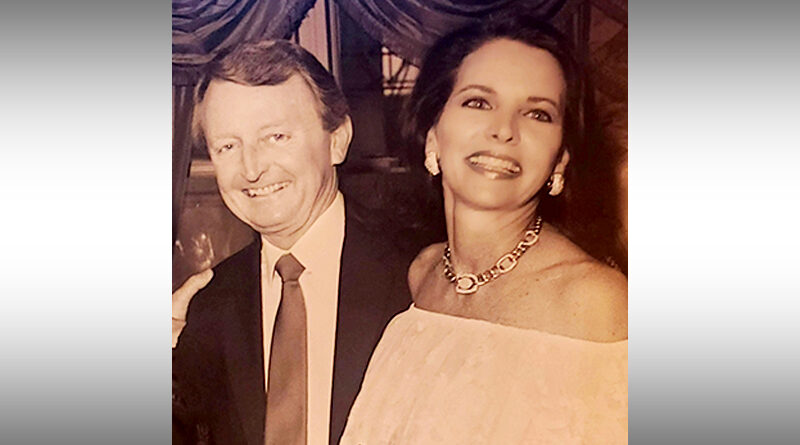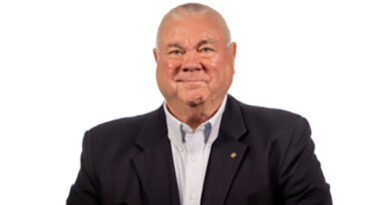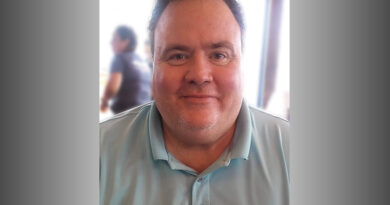Debra Rutherford Thompson
Publisher’s note: The text for this paid obituary was written and provided by family members.
Debra Rutherford Thompson is back dancing in her late husband’s, John Philp Thompson Sr.’s, arms now. She passed away on July 29, in her home in Highland Park, due to a stroke most likely brought on by the stress of her home being rearranged at the request of a Dallas judge who had required that her “stuff” be moved out of her room and reorganized. This caused Debra great anxiety due to Alzheimer’s patients using objects as ways to “root” themselves, resulting in a stroke. While it is deeply painful for those left behind, the family is grateful that she passed instead of remaining trapped in a body due to whatever a stroke might have caused. Debra’s resilience in not only surviving an Alzheimer’s diagnosis many years past what had been expected, but her determination to enjoy life, is a testament to how she had always lived it.
Born on December 11, 1936, to Bonnie Bailey Rutherford, her life as a survivor began when at age six, she witnessed her father Reverend Orvin Buren Rutherford, a Baptist Minister, shot in on the steps of his church on her birthday. Immediately adopted by his sister, Betty Rutherford Sigmund, whom she’d been named after, Debra changed her birth name “Betty” to Debra to avoid confusion. Growing up with her aunt, she was introduced to their family’s Blackfoot “Niitsitapi” Native American heritage as represented by an eagle feather passed down tied with the Rutherford kilt of her grandfather, a cowboy who’d married a Native American woman on the reservation. Growing up in Charleston, South Carolina, she, her siblings, and their father hid their Native American Ancestry due to segregation since they could pass for white. Similarly, her aunt passed on stories and prayers, including a purple rose bush handed down to each generation of women in the family since it had left the Blackfoot reservation generations before.
During this time, Debra assisted her Aunt Betty Rutherford Sigmund and her little brother, Frank Sigmund, in raising black Labradors in kennels. Debra won several awards at the Texas State Fair for the labs she raised.
Arriving in Dallas, Texas, as a child was the first time Debra owned a pair of non-hand-me-down shoes. Hoping to boost the girl’s confidence, her Aunt Betty enrolled her in multiple beauty pageants, leading to Debra’s modeling career and eventually her modeling in print and runway for Neiman Marcus. Paired with a scholarship, Debra used her modeling income to complete her Bachelor of Business Administration degree at Southern Methodist University. During her time there, she wanted to become the majorette and was quickly told that there was no way she could compete with the wealthy Highland Park girls who had had years of personal training and owned their own batons. But Debra practiced with a stick and won the position. While juggling pursuing her education, modeling, and serving as the SMU majorette, she also managed to purchase her first home. She improved it to resell, creating a profit that enabled her to do so again, repeating the process until she eventually owned three houses where she provided a home for her brother Guy Rutherford and his family of three children, Guy, Michael, and Laura, when he had to spend full time caring for his wife who struggled with severe mental illness. Debra purchased the house in Highland Park to ensure that her two nephews and niece had access to the best education possible and used her income to provide the family’s food as well. She then purchased a second home for her Aunt Betty, whose health required her to take a lengthy leave from being employed as a nurse. Endeavoring to complete her education and provide for three households led Debra to increase her modeling career and towards buying, improving, and flipping more houses.
When Debra graduated, she recognized that to become the person she desired to be, she needed to gain the type of social education offered only to the wealthy in the finishing schools of the era and find a way to see the world. Researching, she discovered that becoming an American Airlines Stewardess would allow her to do both. She proudly served as a stewardess, leading her to travel and eventually relocate to Chicago while maintaining various Dallas properties for resale and rentals. As her aunt became healthy again, she helped Debra build upon the nurse’s training offered to stewardess so that Debra could help her aunt to save women’s lives in Chicago and Dallas who had been hurt by botched back-ally abortions and felt they couldn’t risk going to a hospital. The two women did this throughout much of Debra’s time as a stewardess.
Also during this time, Debra would meet with her close friend, Pat Kerr, a fellow model and then-burgeoning fashion designer, in New York. The two were fond of gaining access to exclusive clubs and restaurants by Debra urgently telling the hosts, “Don’t you know who she IS?!?!?,” while Pat Kerr, dressed in her best clothes, pretended to be haughty as her “assistant,” Debra chided the businesses for not immediately recognizing her! As a result, the two gorgeous women enjoyed multiple comped meals, drinks, and dance clubs.
By the time Debra had been promoted to serving as the hostess overseeing the Dallas Admiral’s Club, she had become a self-made millionaire from her smart real estate investments. When the planes in John Philp Thompson, Sr.’s fleet were all down for repair, causing him to book a commercial flight, he met Debra at the Admiral’s Club. After a recent divorce, John found her beautiful and charming, with a wicked sense of humor. But he had had friends who had insisted that they knew a woman who he just absolutely needed to meet due to relating to how he’d helped his father build 7-Eleven from the ground up. Thinking that he should first meet that lady since he had found it difficult to relate to socialites who’d been born into money without the experience of building up a dream, he decided to accept the invitation to a blind double date only to discover it was Debra! The two got a great deal of amusement from this and eventually married in 1975.
Accustomed to helping her aunt in secret, Debra took John’s juggling of his life as CEO of 7-Eleven with his history of secretly assisting human rights leaders in stride. She was proud that she had not shared his stories of meeting with Hispanic students at the University of Texas to tell them when, where, and who to protest to fight against the then-unspoken school policy of not allowing brown students to enter graduate schools until after he passed in 2003. She didn’t reveal that she knew that John had coordinated with MLK Jr’s representative, Reverend Peter Johnson, to help fight segregation until Rev. Johnson openly discussed it decades later. Similarly, when the couple decided to adopt a child, they were repeatedly told they were too old or worse. After naming and buying twin beds for a pair of African American twins, Debra and John were told they “were the wrong race and therefore could not qualify to adopt them.” Heartbroken, the couple reached out to a friend, Reverend William Wasson, who operated “Our Little Children of the World Orphanages” in Mexico. The priest refused because allowing the adoption of a child would make the other children feel bad. But then, at 7:11 a.m. on Mother’s Day in 1977, when a little girl was born, Father Wasson took it as a sign that God wanted Debra and John to have the child. When the couple presented their daughter in Dallas, half of their guests left due to not approving of interracial adoption. This led the couple to not only take a stronger stand against racism and prejudice of any kind but to Debra also reclaiming her Native American heritage publicly–being proud to claim it alongside the Rutherford Clan.
Debra and John struggled with assisting the girl born with hearing loss, seizures, migraines, and severe asthma through much of her childhood while continuing to stand for their beliefs in fundamental human and civil rights. Having had three other children from a previous marriage battling asthma, John was passionate about establishing an ER for asthmatic children in Dallas. Debra joined him in advocating for it. The two welcomed a friend dying of AIDS into their home in the ’80s and balanced raising a child with health issues with John’s career and Debra’s continuing real estate investments. They were also the never-caught couple “technically breaking the law” by delivering coats and blankets to people experiencing homelessness underneath the highway overpasses in the city during freezes from their van. They sped away from police cars attempting to ticket them for doing so. The two took a strong stand in the 1990s against homophobia when John refused to ban the Dallas LGBT community from hosting an LGBT human rights march at the State Fair of Texas and ignored threats to the family, pressuring him to do otherwise.
Sadly, burdened with bipolar and residual trauma from what she’d witnessed as a child, Debra became more reclusive but would still have bursts of unpredictable charisma, known for carrying large purses full of candy bars that she’d happily pass out to strangers. During this time, she was known for such antics as showing up dressed like a cat or, in later years, taking the Christmas lights off of a Christmas tree in a restaurant, wrapping them around herself, jumping on the piano, and tossing the plug at her husband with “John, plug me in!,” then leading the restaurant in Christmas carols.
In later years, as Debra’s bipolar came back under control, the couple enjoyed hiking at their Aspen Valley home and the culture and flavors at Casa Thompson in Cuernavaca, Mexico. After John’s passing, Debra explored multiple area churches and chose the Cathedral of Hope for two reasons, she “loved the choir and was grateful for a minister who kept to the topic of The Lord and not trying to tell the congregation how to vote from the pulpit.” When friends and family expressed concern over her safety due to the hateful protestors who’ sometimes hassled congregants that she’d have to walk through, Debra replied in her signature South Carolina drawl, “Oh honey, they’d have to do much more than that to worry me. My father had an integrated church in South Carolina where we faced down protestors outside each Sunday. If they think they’re intimidating, that’s a joke, as I’ve seen so much worse.” She’d attend each Sunday with her close friend Joel Flores until COVID caused the church to cancel later services. During COVID, she insisted on learning to walk again after breaking a hip. She had to be begged to agree to ride a wheelchair in the Dallas Women’s March, where, as a Native American elder, she was invited to be wheeled at the front of the 6,000 women march from the Arts District to City Hall.
When she lost the ability to stand and walk by herself due to intestinal surgery, she still asked to lead as active a life as possible. She became known for ‘dancing” via Stephen Stefanou’s moving her wheelchair across the floor so that she could join friends and family in celebrations at her daughter’s, Mary Ann’s, and son-in-law’s, Joshua’s, home. Having been a trained tap and ballet dancer as a young woman, who’d then mastered swing, samba, and salsa with John, she loved movies and plays with musical dance numbers. She enjoyed her times at home listening with Alma Nellums to their favorite blues and gospel songs. Strong-willed, she even shocked attendees at Mary Ann’s and Joshua’s home when she jumped out of her wheelchair to dance with Joel Flores for a few brief moments to Singer Lady Diamond’s music.
Having been blessed with a strong green thumb, Debra leaves behind numerous rose bushes that she spent so much time tending; her brother, Frank Sigmund; numerous nieces and nephews from her six siblings that she had reunions with up through the ’90s; her daughter, Mary Ann Thompson-Frenk, and son-in-law, Joshua Raymond Frenk; as well as her grown stepchildren from John’s prior marriage, Peggy Thompson Wolfe, Douglas Thompson, and John Philp Thompson, Jr.; as well as their children, Tyler Wolfe, Parker Wolfe, Clark Thompson, Liza Thompson Sorgenfrei, John Philp Thompson III, Caroline Thompson Richards, Lauren Thompson Bailey, and Crawford Thompson; as well as brothers-in-law, Jere W. Thompson, Sr. and Joe C. Thompson Sr.
She also leaves behind a legacy among friends who loved the woman so fond of joking, “A good man is hard to find, you always seem to get the other kind….”, then wink, “…but honey, you’re different… you’re a good one!” Our family wishes to extend special thanks to all those who made an effort to spend time with her in her last years, as we believe it was due to her enjoying an active social life that her will to continue enjoying life was made possible. A special note of gratitude, therefore, goes to Alma Nellums, Billy Bob Harris, Joan Wynne, and ESPECIALLY to Marcela Gerber, Ron Davis, Vince Pradia, Alan Keith, Joe Pacetti, and Joel Flores for making her a priority in your lives.
Debra was fond of saying, “The Good Lord never gives us more than we can handle, but sometimes I wish He didn’t believe in me so much!” She was a woman who built her dreams, struggled past immense adversities of prejudice, mental illness, and finances to create a life she was proud of, and was a known source of laughter with her signature, not always PG, wit. A staple at Bistro 31 and Celebration, she believed in good food shared in good times with loved ones. She leaves us with this last piece of advice, “Everyone has something good about them. If someone’s just awful, perhaps their hair looks good. But the truth is, if you can’t find something nice to say about someone, then the problem might be with you. Work on that. And when you see something good about another person, tell them. Make them feel good. It costs nothing to brighten someone’s day.”
A visitation for Debra will be held Wednesday, August 9, 2023, from 6 to 8 p.m. at Calvary Hill Funeral Home, 3235 Lombardy Lane, Dallas, Texas 75220. The “Celebration of Life” will occur Thursday, August 10, 2023, at 3 p.m. at Cathedral of Hope, 5910 Cedar Springs Road, Dallas, Texas 75235, followed by a wake at her daughter and son-in-law’s home, the address of which will be provided at the funeral. On the 14th, her cremated remains will be placed next to her husband, John Philp Thompson, Sr., in the Thompson Family plot at Calvary Hill.








